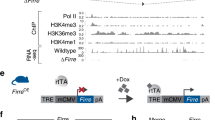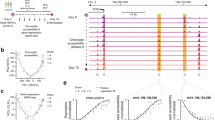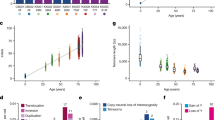Abstract
We mapped quantitative trait loci that accounted for the variation in hematopoietic stem cell (HSC) numbers between young adult C57BL/6 (B6) and DBA/2 (D2) mice. In reciprocal chromosome 3 congenic mice, introgressed D2 alleles increased HSC numbers owing to enhanced proliferation and self-renewal and reduced apoptosis, whereas B6 alleles had the opposite effects. Using oligonucleotide arrays, real-time PCR and protein blots, we identified latexin (Lxn), a gene whose differential transcription and expression was associated with the allelic differences. Expression was inversely correlated with the number of HSCs; therefore, ectopic expression of Lxn using a retroviral vector decreased stem cell population size. We identified clusters of SNPs upstream of the Lxn transcriptional start site, at least two of which are associated with potential binding sites for transcription factors regulating stem cells. Thus, promoter polymorphisms between the B6 and D2 alleles may affect Lxn gene expression and consequently influence the population size of hematopoietic stem cells.
This is a preview of subscription content, access via your institution
Access options
Subscribe to this journal
Receive 12 print issues and online access
$209.00 per year
only $17.42 per issue
Buy this article
- Purchase on Springer Link
- Instant access to full article PDF
Prices may be subject to local taxes which are calculated during checkout







Similar content being viewed by others
References
Muller-Sieburg, C. & Riblet, R. Genetic control of the frequency of hematopoietic stem cells in mice: Mapping of a candidate locus to chromosome 1. J. Exp. Med. 183, 1141–1150 (1996).
de Haan, G., Nijhof, W. & Van Zant, G. Mouse strain-dependent changes in frequency and proliferation of hematopoietic stem cells during aging: correlation between lifespan and cycling activity. Blood 89, 1543–1550 (1997).
Chen, J., Astle, C.M. & Harrison, D.E. Genetic regulation of primitive hematopoietic stem cell senescence. Exp. Hematol. 28, 442–450 (2000).
Morrison, S.J. et al. A genetic determinant that specifically regulates the frequency of hematopoietic stem cells. J. Immunol. 168, 635–642 (2002).
Henckaerts, E. et al. Genetically determined variation in the number of phenotypically defined hematopoietic progenitor and stem cells and in their response to early-acting cytokines. Blood 99, 3947–3954 (2002).
de Haan, G. & Van Zant, G. Intrinsic and extrinsic control of hemopoietic stem cell numbers: mapping of a stem cell gene. J. Exp. Med. 186, 529–536 (1997).
Van Zant, G., Holland, B.P., Eldridge, P.W. & Chen, J.-J. Genotype-restricted growth and aging patterns in hematopoietic stem cell populations of allophenic mice. J. Exp. Med. 171, 1547–1565 (1990).
Bailey, D. Recombinant-inbred strains, an aid to finding identity, linkage, and function of histocompatibility and other genes. Transplantation 11, 325–327 (1971).
de Haan, G. & Van Zant, G. Dynamic changes in mouse hematopoietic stem cell numbers during aging. Blood 93, 3294–3301 (1999).
Geiger, H., Rennebeck, G. & Van Zant, G. Regulation of hematopoietic stem cell aging in vivo by a distinct genetic element. Proc. Natl. Acad. Sci. USA 102, 5102–5107 (2005).
de Haan, G. & Van Zant, G. Genetic analysis of hemopoietic cell cycling in mice suggests its involvement in organismal life span. FASEB J. 13, 707–713 (1999).
Geiger, H., True, J.M., de Haan, G. & Van Zant, G. Age- and stage-specific regulation patterns in the hematopoietic stem cell hierarchy. Blood 98, 2966–2972 (2001).
Henckaerts, E., Langer, J.C., Orenstein, J. & Snoeck, H.W. The positive regulatory effect of TGF-beta2 on primitive murine hemopoietic stem and progenitor cells is dependent on age, genetic background, and serum factors. J. Immunol. 173, 2486–2493 (2004).
Liang, Y. & Van Zant, G. Genetic control of stem-cell properties and stem cells in aging. Curr. Opin. Hematol. 10, 195–202 (2003).
van der Sluijs, J.P., de Jong, J.P., Brons, N.H. & Ploemacher, R.E. Marrow repopulating cells, but not CFU-S, establish long-term in vitro hemopoiesis on a marrow-derived stromal layer. Exp. Hematol. 18, 893–896 (1990).
Markel, P. et al. Theoretical and empirical issues for marker-assisted breeding of congenic mouse strains. Nat. Genet. 17, 280–284 (1997).
Wakeland, E., Morel, L., Achey, K., Yui, M. & Longmate, J. Speed congenics: a classic technique in the fast lane (relatively speaking). Immunol. Today 18, 472–477 (1997).
Yilmaz, O.H., Kiel, M.J. & Morrison, S.J. SLAM family markers are conserved among hematopoietic stem cells from old and reconstituted mice and markedly increase their purity. Blood 107, 924–930 (2006).
Kiel, M.J. et al. SLAM family receptors distinguish hematopoietic stem and progenitor cells and reveal endothelial niches for stem cells. Cell 121, 1109–1121 (2005).
Szilvassy, S., Humphries, R., Lansdorp, P., Eaves, A. & Eaves, C. Quantitative assay for totipotent reconstituting hematopoietic stem cells by a competitive repopulation strategy. Proc. Natl. Acad. Sci. USA 87, 8736–8740 (1990).
Bradford, G.B., Williams, B., Rossi, R. & Bertoncello, I. Quiescence, cycling, and turnover in the primitive hematopoietic stem cell compartment. Exp. Hematol. 25, 445–453 (1997).
Cheshier, S.H., Morrison, S.J., Liao, X. & Weissman, I.L. In vivo proliferation and cell cycle kinetics of long-term self-renewing hematopoietic stem cells. Proc. Natl. Acad. Sci. USA 96, 3120–3125 (1999).
Arimatsu, Y. et al. Early regional specification for a molecular neuronal phenotype in the rat neocortex. Proc. Natl. Acad. Sci. USA 89, 8879–8883 (1992).
Arimatsu, Y., Nihonmatsu, I., Hirata, K. & Takiguchi-Hayashi, K. Cogeneration of neurons with a unique molecular phenotype in layers V and VI of widespread lateral neocortical areas in the rat. J. Neurosci. 14, 2020–2031 (1994).
Bystrykh, L. et al. Uncovering regulatory pathways that affect hematopoietic stem cell function using 'genetical genomics'. Nat. Genet. 37, 225–232 (2005).
Chesler, E.J. et al. Complex trait analysis of gene expression uncovers polygenic and pleiotropic networks that modulate nervous system function. Nat. Genet. 37, 233–242 (2005).
Flint, J. & Mott, R. Finding the molecular basis of quantitative traits: successes and pitfalls. Nat. Rev. Genet. 2, 437–445 (2001).
Arimatsu, Y. Latexin: a molecular marker for regional specification in the neocortex. Neurosci. Res. 20, 131–135 (1994).
Normant, E., Martres, M.P., Schwartz, J.C. & Gros, C. Purification, cDNA cloning, functional expression, and characterization of a 26-kDa endogenous mammalian carboxypeptidase inhibitor. Proc. Natl. Acad. Sci. USA 92, 12225–12229 (1995).
Liu, Q. et al. Cloning, tissue expression pattern and genomic organization of latexin, a human homologue of rat carboxypeptidase A inhibitor. Mol. Biol. Rep. 27, 241–246 (2000).
Aagaard, A. et al. An inflammatory role for the mammalian carboxypeptidase inhibitor latexin: relationship to cystatins and the tumor suppressor TIG1. Structure 13, 309–317 (2005).
Callahan, G., Shridhar, V., Hartmann, L. & Smith, D. Characterization of a carboxypeptidase-A inhibitor identified by DD-PCR in primary ovarian tumors and cell lines. FASEB J., f637 (1999).
Jin, M., Uratani, Y. & Arimatsu, Y. Mapping to mouse chromosome 3 of the gene encoding latexin (Lxn) expressed in neocortical neurons in a region-specific manner. Genomics 39, 419–421 (1997).
Youssef, E.M. et al. Hypermethylation and silencing of the putative tumor suppressor Tazarotene-induced gene 1 in human cancers. Cancer Res. 64, 2411–2417 (2004).
Zhang, J., Liu, L. & Pfeifer, G.P. Methylation of the retinoid response gene TIG1 in prostate cancer correlates with methylation of the retinoic acid receptor beta gene. Oncogene 23, 2241–2249 (2004).
Kwong, J. et al. Silencing of the retinoid response gene TIG1 by promoter hypermethylation in nasopharyngeal carcinoma. Int. J. Cancer 113, 386–392 (2005).
Jing, C. et al. Tazarotene-induced gene 1 (TIG1) expression in prostate carcinomas and its relationship to tumorigenicity. J. Natl. Cancer Inst. 94, 482–490 (2002).
Feinberg, A.P., Ohlsson, R. & Henikoff, S. The epigenetic progenitor origin of human cancer. Nat. Rev. Genet. 7, 21–33 (2006).
Androutsellis-Theotokis, A. et al. Notch signalling regulates stem cell numbers in vitro and in vivo. Nature 442, 823–826 (2006).
Duncan, A.W. et al. Integration of Notch and Wnt signaling in hematopoietic stem cell maintenance. Nat. Immunol. 6, 314–322 (2005).
Geiger, H. & Van Zant, G. The aging of lympho-hematopoietic stem cells. Nat. Immunol. 3, 329–333 (2002).
Sauvageau, G. et al. Overexpression of HOXB4 in hematopoietic cells causes the selective expansion of more primitive populations in vitro and in vivo. Genes Dev. 9, 1753–1765 (1995).
Acknowledgements
We acknowledge the flow cytometric expertise of B. Grimes, the technical assistance of C. Swiderski and the editorial assistance of P. Thomason. This work was supported by the US National Institutes of Health (grants AG020917, AG024950 and AG022859).
Author information
Authors and Affiliations
Contributions
Y.L. performed the majority of the experimental work in the course of her Ph.D. dissertation project, contributed to the design of the study and contributed to the writing of this paper. M.J. and B.A. contributed to the Lxn promoter SNP analyses and identification of potential regulatory sites. H.G. generated the congenic strains, carried out initial phenotyping of the congenics and contributed to the writing of this paper. G.V.Z. was largely responsible for the design of the study and writing of this paper.
Corresponding author
Ethics declarations
Competing interests
The authors declare no competing financial interests.
Supplementary information
Supplementary Table 1
CAFC day 35 numbers in B6, D2 nad BXD recombinant inbred strains. (PDF 44 kb)
Supplementary Table 2
Hematopoietic progenitor cells (HPCs) and peripheral blood cell counts in Chr3 congenic and background mouse strains. (PDF 54 kb)
Supplementary Table 3
Genes differentially expressed in LSK cells between B.D Chr3 congenic and B6 strains. (PDF 80 kb)
Supplementary Table 4
Genes differentially expressed in LSK cells between D.B Chr3 and D2 strains. (PDF 75 kb)
Supplementary Table 5
Confirmation of SNPs between B6 and D2 alleles in the regulatory region of Lxn. (PDF 60 kb)
Rights and permissions
About this article
Cite this article
Liang, Y., Jansen, M., Aronow, B. et al. The quantitative trait gene latexin influences the size of the hematopoietic stem cell population in mice. Nat Genet 39, 178–188 (2007). https://doi.org/10.1038/ng1938
Received:
Accepted:
Published:
Issue Date:
DOI: https://doi.org/10.1038/ng1938
This article is cited by
-
Loss of LXN promotes macrophage M2 polarization and PD-L2 expression contributing cancer immune-escape in mice
Cell Death Discovery (2022)
-
Latexin deficiency attenuates adipocyte differentiation and protects mice against obesity and metabolic disorders induced by high-fat diet
Cell Death & Disease (2022)
-
Latexin deficiency in mice up-regulates inflammation and aggravates colitis through HECTD1/Rps3/NF-κB pathway
Scientific Reports (2020)
-
Cathepsin V Mediates the Tazarotene-induced Gene 1-induced Reduction in Invasion in Colorectal Cancer Cells
Cell Biochemistry and Biophysics (2020)
-
The emerging role of the piRNA/piwi complex in cancer
Molecular Cancer (2019)



